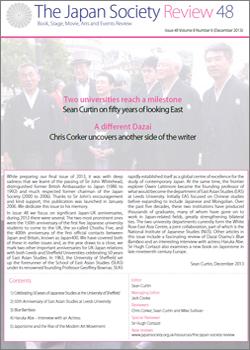Issue 48 (December 2013, Volume 8, Number 6)

While preparing our final issue of 2013, it was with deep sadness that we learnt of the passing of Sir John Whitehead, distinguished former British Ambassador to Japan (1986 to 1992) and much respected former chairman of the Japan Society (2000 to 2006). Thanks to Sir John’s encouragement and kind support, this publication was launched in January 2006. We dedicate this issue to his memory.
In issue 48 we focus on significant Japan-UK anniversaries, during 2013 there were several. The two most prominent ones were the 150th anniversary of the first five Japanese university students to come to the UK, the so-called Choshu Five, and the 400th anniversary of the first official contacts between Japan and Britain, known as Japan400.
We have covered both of these in earlier issues and, as the year draws to a close, we mark two other important anniversaries for UK-Japan relations with both Leeds and Sheffield Universities celebrating 50 years of East Asian Studies. In 1963, the University of Sheffield set up the forerunner of the School of East Asian Studies (SEAS) under its renowned founding Professor Geoffrey Bownas. SEAS rapidly established itself as a global centre of excellence for the study of contemporary Japan. At the same time, the frontier explorer Owen Lattimore became the founding professor of what would become the department of East Asian Studies (EAS) at Leeds University. Initially EAS focused on Chinese studies before expanding to include Japanese and Mongolian. Over the past five decades, these two institutions have produced thousands of graduates, many of whom have gone on to work in Japan-related fields, greatly strengthening bilateral ties. The two university departments currently form the White Rose East Asia Centre, a joint collaboration, part of which is the National Institute of Japanese Studies (NIJS).
Other articles in this issue include a fascinating review of Dazai Osamu’s Blue Bamboo and an interesting interview with actress Haruka Abe.
Sir Hugh Cortazzi also examines a new book on Japonisme in late nineteenth century Europe.
Contents
- Celebrating 50 years of Japanese Studies at the University of Sheffield
- 50th Anniversary of East Asian Studies at Leeds University
- Blue Bamboo
- Haruka Abe – Interview with an Actress
- Japonisme and the Rise of the Modern Art Movement
Contributors
Editor
Sean Curtin
Managing Editor
Jack Cooke
Special Reviewer
Sir Hugh Cortazzi
Reviewers
Chris Corker, Sean Curtin and Mike Sullivan

